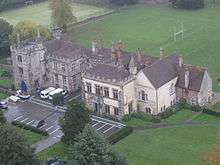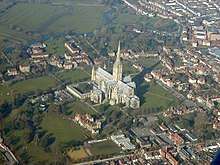Salisbury Cathedral School
Salisbury Cathedral School is a co-educational independent school in Salisbury, Wiltshire, England. It was founded in 1091 by Saint Osmund at Old Sarum.[2][3]
| Salisbury Cathedral School | |
|---|---|
 | |
| Address | |
1 The Close , , SP1 2EQ | |
| Coordinates | 51.063777°N 1.795966°W |
| Information | |
| Type | Independent preparatory day and boarding school Choral foundation school Cathedral school |
| Motto | Domine dilexi decorem domus tuae[1] |
| Religious affiliation(s) | Church of England |
| Established | 1091 |
| Founder | Saint Osmund |
| Department for Education URN | 126518 Tables |
| Chair of Governors | Robert Key, former MP of Salisbury |
| Headmaster | Mr Clive Marriott |
| Staff | 38 |
| Gender | Mixed |
| Age | 3 to 13 |
| Enrolment | 250 |
| Houses | 4 |
| Website | http://www.salisburycathedralschool.com/ |
History
The school was founded by Saint Osmund, the Bishop of Old Sarum and Earl of Dorset, who was recognised for his good works when he was canonised several hundred years later in 1456.[4][5] Osmund was born in Normandy and was a first cousin of William the Conqueror, King of England: William's father, Robert the Magnificent, Duke of Normandy, was the brother of Isabella, Countess of Séez, the mother of Osmund.[4]
The first notable pupil of the school was John of Salisbury, who served Archbishop Thomas Becket until the latter was murdered in 1170. John was quoted by Queen Eleanor of Aquitaine.[6]
Originally, the school would have been housed near the cathedral at Old Sarum. At the start of the 13th century the centre of the Diocese of Salisbury was moved from Old Sarum to its present site. The choristers would then have lodged with various canons in the new Cathedral Close. After 1319, a house was built in The Close to accommodate the School (known as 'The Choristers' House'). The School remained here for the next 300 years. The choristers were educated in the Chancellor's Grammar School nearby.
In 1714, the School moved to a new School House built for it on the north-west side of The Close. This became known as Wren Hall which, with the house connected to it (Braybrooke House), acted as the centre of the school campus until the middle of the 20th century. As this site could not keep pace with the growing size of the School, the school was relocated, in 1946/47, to the former Bishop's Palace in the grounds of the cathedral. The building is designated as a Grade I listed building by English Heritage.[7]
The Choristers of Salisbury Cathedral are educated at the school.
In 1987, the first girls were admitted. In a landmark move, the cathedral became the first in England to allow female choristers when it opened its choristership programme to girls in 1991.[8]
A library partly funded by the former bookstore chain Ottakar's was opened in October 2002. Two members of the Heneage family, who owned the company, were former pupils.
The school featured in a BBC television documentary entitled Angelic Voices: The Choristers of Salisbury Cathedral, which was first broadcast in March 2012.
The school merged with Leaden Hall, an all-girls school in The Close, in March 2016. The combined school is called Salisbury Cathedral School, and the Headmaster remains.[9]
Location

The school's 27-acre campus[10] is located adjacent to Bishop Wordsworth's School, in the southern part of Salisbury Cathedral Close, which at 80 acres (320,000 m2) is the largest Cathedral Close in Britain.[11] The main school building is the former Bishop's Palace, parts of which date from the building of the cathedral in the 13th century. The pre-preparatory part of the school is located in newer buildings adjacent to the palace, but uses some of the main school facilities. The boarding house is also located in The Close. Sports facilities include football, rugby and cricket pitches, an athletics track, tennis courts/hockey pitches (Astro Turf) and an outdoor swimming pool.
Academics
Scholarships are offered on entry to the school at Years 3 and 6, with choral scholarships offered at Years 4 and 5. An exchange programme with pupils from Union High School, South Africa, is available to Year 7 students.
Pupils generally take the Common Entrance Exam at the end of Year 8 and many progress to senior independent schools.[12] Some also leave at Year 6 for local grammar schools, or other independent schools.
Choir
The school continues to serve its original function of educating choristers of the cathedral choir. Every year auditions are held for children between ages 7 and 9 and successful applicants receive scholarships to attend the school.[13] It was the first English cathedral to allow girls to become choristers, and is unique in that the girls have equal duties with the boys. Many choristers board in a large boarding house located near the school.[14]
Notable former pupils
- John of Salisbury (c. 1120–1180): Author, diplomat and Bishop of Chartres[15]
- Henry Lawes (1595–1662): Musician and composer. A Gentleman of the Chapel Royal in the reigns of King Charles I & King Charles II. He was appointed Musician in the 'Private Musick for the Voices' to King Charles II. (Buried in Westminster Abbey).[15]
- William Lawes (1602–1645): Brother of Henry Lawes (above). Composer and musician. Appointed as 'Musician in Ordinary for Lutes and Voices' to King Charles I. He was killed during the rout of the Royalists at the Battle of Rowton Heath.[15]
- Edward Lowe (c.1602–1682): Composer, author & organist. Professor of Music at Oxford University (1671 - 1682).[15]
- Sir Stephen Fox (1627–1716): [Noted in John Evelyn's Diary as ‘…a poore boy from the quire of Salisbury’].[16] Founder of The Royal Hospital, Chelsea; Commissioner of the Treasury.[17][18]
- Thomas Wyndham, 1st Baron Wyndham of Finglass (1681–1745): Lawyer; Lord Chancellor of Ireland (1728); Lord High Steward of Ireland (1739).[15][17]
- John Greenhill (1644?–1676): English portrait painter and draughtsman (Associated with 24 major portraits). Pupil of Sir Peter Lely.[15]
- Henry Greenhill (1646–1708): (Brother of John Greenhill, above) As a Commissioner of the Admiralty, directed the building of Plymouth Dockyard.[15]
- James Harris (1709–1780): Grammarian and politician.[19][20]
- James Harris, 1st Earl of Malmesbury GCB (1746–1820): Son of the above and noted diplomat.[21]
- William Benson Earle (1740–1796): Author & composer.[22]
- Sir George Ridout Bingham, KCB (1777–1833): Army Officer in the Peninsular War. Commanded the garrison of St.Helena guarding the Emperor Napoleon.[15][23]
- Bernard George Ellis (1890–1979): Winner of the George Cross in 1918.[24]
- Walter Kendall Stanton (1891–1978): Organist & composer. Director of BBC Midland Radio Music. Editor of the BBC Hymn Book. First Professor of Music at Bristol University.[15][25]
- Stephen Clissold (1913–1982): Author: subjects include mediæval mystics, Latin America & Yugoslavia. In 2nd World War, worked with the British Mission to Yugoslavia. He was the interpreter between Sir Winston Churchill & Marshal Tito at their first meeting.[15][25][26]
- Doctor Bernard Rose (1916–1996): Don, organist and master of the choristers, Magdalen College, Oxford.
- Professor John Blacking (1928–1990): Anthropologist and ethnomusicologist.[17]
- Professor Nicholas Daniel (born 1962): Oboist & conductor.[27]
- David Gascoyne (1916–2001): Surrealist poet.[28]
- Air Vice-Marshal David Hills CB OBE (born 1925)[29]
- Robert Key MP (born 1945): Conservative politician.[30]
- Michael Mates MP (born 1934): Conservative politician.[31]
- Martin Woodhouse (1932 - 2011): Author and scriptwriter.
- Jonathan Meades (born 1947): Writer and television film-maker.[32]
- Mike Wedgwood (born 1950): Bass guitarist, formerly a member of The Overlanders, Curved Air and Caravan.[32]
- Robert Wilkie (born 1962): Former Assistant Secretary of Defense (United States) and Special Assistant to the President of the United States for National Security Affairs.
See also
References
- Salisbury Cathedral School Motto: "Domine dilexi decorem domus tuae" Psalm 25:8: 'I have loved, O Lord, the beauty of thy house'. [Originally suggested as the School's motto by Bishop George Moberly - c.1885]
- 'The cathedral of Salisbury: From the foundation to the fifteenth century', A History of the County of Wiltshire: Volume 3 (1956), pp. 156–183. URL: http://www.british-history.ac.uk/report.aspx?compid=36531. Date accessed: 28 January 2008.
- Nicholas Orme, 'School founders and patrons in England, 597–1560', Oxford Dictionary of National Biography, online edn, Oxford University Press, Oct 2006, accessed 28 Jan 2008
- Powicke Handbook of British Chronology p. 81
- Robertson, Dora H., Sarum Close (Jonathan Cape, 1938; 2nd.ed. 1969)
- Power of a woman:Memoirs of a turbulent life: Eleanor of Aquitaine p.339 by Robert Fripp. ISBN 978-0-9780621-0-1 accessed 24 January 2008
- English Heritage Images of England reference no. 318958
- History Archived 8 September 2012 at Archive.today
- http://www.salisburycathedralschool.com/scs/leadenhall-salisburycathedralschool#8o1MSbwbpa3PojDy.97
- Salisbury Cathedral School. Pre-Prep School prospectus, accessed January 2008
- "Visitor Information, Salisbury Cathedral". Retrieved 25 January 2008.
- Curriculum Archived 21 April 2012 at the Wayback Machine
- Choristers
- "Day in the Life of a Border". salisburycathedralschool.com. Retrieved 29 March 2016.
- Osmond, Stephen E., Register of Past & Present Pupils of the Cathedral School Salisbury (5th.Ed. 2002; publ. Salisbury Cathedral School Association)
- Diary of John Evelyn: (6 September 1680)
- in Oxford Dictionary of National Biography, Oxford University Press, 2004
- Clay, Christopher: 'Public Finance & Private Wealth; The Career of Sir Stephen Fox', (Oxford University Press, 1978).
- Probyn, Clive T.: 'The Sociable Humanist; The Life & works of James Harris' (Oxford University Press. 1991)
- Burrows, Donald and Dunhill, Rosemary. 2002. Music and Theatre in Handel's World: The Family Papers of James Harris 1732–1780. Oxford University Press. ISBN 0-19-816654-0.
- Harris, James, first earl of Malmesbury (1746–1820), diplomatist by H. M. Scott in Oxford Dictionary of National Biography, Oxford University Press, 2004
- Earle, William Benson, in Oxford Dictionary of National Biography, Oxford University Press, 2004
- Glover, Gareth: Wellington's Lieutenant - Napoleon's Gaoler (The Peninsula Letters & Diaries of Sir George Ridout Bingham) (publ. Pen & Sword Books - 2005)
- Ellis on The Comprehensive Guide to the Victoria & George Cross
- Smith, Peter L.: In the Shadow of Salisbury Spire (publ. The Hobnob Press - 2011)
- Catalogue of papers of Stephen Clissold (1913–1982), 1940–1982 - Bodleian Library, University of Oxford
- DANIEL, Nicholas in Who's Who 2007 (London, A. & C. Black, 2007)
- Barker, Sebastian. Obituary: David Gascoyne. The Independent. 28 November 2001.
- HILLS, Air Vice-Marshal David Graeme Muspratt in Who's Who 2007 (London, A. & C. Black, 2007)
- KEY, (Simon) Robert in Who's Who 2007 (London, A. & C. Black, 2007)
- MATES, Lt-Col Rt Hon. Michael (John) in Who's Who 2007 (London, A. & C. Black, 2007)
- Meades, Jonathan (2014). An Encyclopaedia of Myself. Fourth Estate, London. ISBN 978-1-85702-905-5.